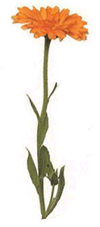
Calendula
Introduction
This fact sheet provides basic information about Calendula. Calendula is believed to be native to Egypt and has almost worldwide distribution. There are numerous varieties of this species, differing primarily in flower shape and color. The plant has been grown in European gardens since the 12th century, and its folkloric uses are almost as old. Tinctures and extracts of the florets were used topically to promote wound healing and to reduce inflammation; systemically, they have been used to reduce fever, control dysmenorrhea, and treat cancer. The plant is listed in the German Commission E Monographs for wound healing and anti-inflammatory actions.Common Names
Calendula, Garden Marigold, Gold Bloom, Holligold, Marygold, Pot MarigoldLatin Names
Calendula officinalisWhat It Is Used For
- Wound healing
- Anti-inflammatory
- Burns (minor, including sunburn)
- Conjunctivitis
- Eczema
- Gastritis
- Injuries (minor)
- Peptic ulcer
- Ulcerative colitis
- Sore Throat
- Considered by many to be an effective detoxifying herb that can help with the toxicity associated many severe fevers and infections.
- Oil extracted from the calendula herb - externally applied to the ear, has been reported to alleviate pain and discomfort from an earache.
- Oil extracted - taken internally, it may aid in eliminating fever, soothing a festering ulcer, and relieving discomfort of menstrual cramps.
- Widely recognized as a cleanser for the liver, gallbladder, and other organs.
- The pungent odor of the marigold has been used as an effective pesticide. Marigolds are often interspersed among vegetable plants to repel insects.
How It Is Used
Petals of the calendula have been used in herbal preparations for hundreds of years.Dosage and Administration:
- To make calendula tea simply pour 200 ml of boiling water over 1-2 teaspoons of calendula flowers and let sit for 15 minutes. Calendula tea may be taken 3 times per day.
- Calendula tincture, which can be taken with water or tea, can be taken 3 times a day (in doses of 1-2 ml). To make calendul tincture soak a cup of flowers in .5 quarts of rectified alcohol or whiskey for 5 to 6 weeks. A tincture dose is 5 to 15 drops.
- To make calendula juice take 1 tsp of freshly pressed
- To create a calendula salve for external application boil 1 oz dried flowers or leaves with 1 oz lard.
What the Science Says
- Despite the history of calendula use and the detailed studies of its chemistry, there are few clinical studies available.
Side Effects and Cautions
- Limited evidence is available to guide usage in pregnancy.
- There are few reports describing serious reactions to the widespread use of calendula preparations.
- Allergic reactions, contact sensitization, and one case of anaphylaxis to other members of the Asteraceae family have been described.
Sources
- Drugs.Com Web site. Accessed on February 6, 2009.
- From Wikipedia, the free encyclopedia. Accessed on February 6, 2009.






